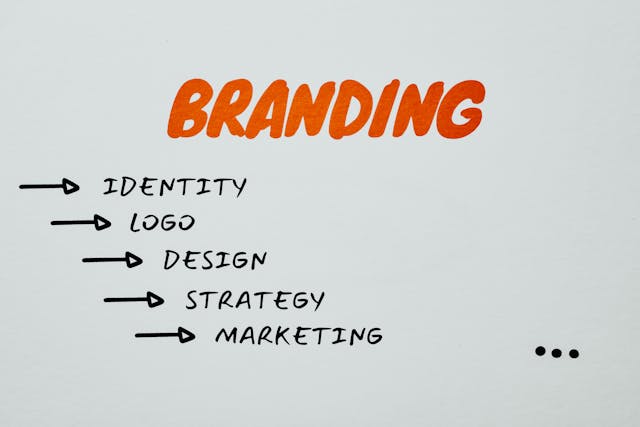What do the colours in your brand say about your business?

A couple of years ago public opinion in the UK was split down the middle on a highly contentious issue. It confused and polarised people as they tried to understand what on earth those in the other camp were thinking. No, it’s not Brexit. Go back a year. I’m talking about ‘The dress’. If you somehow missed it, ‘The dress’ was an eBay photo that went viral due to a peculiar quirk of lighting. Depending on the person looking at it, the stripy dress could appear as blue and black, or white and gold. What this tells us is that people become very annoyed and vocal about apparently trivial arguments. But it also shows that people have strong opinions about what they’re looking at. When you’re deciding on the visual elements of your branding, that’s not trivial at all. Colours and moods There have been countless studies into the associations and effects of different colours – in fact colours have long been associated with moods – we see red, we feel blue, we go white with fear or turn green with envy. What colours mean to us is subjective – while purple may suggest royalty and wealth, in Brazil and Thailand it’s the colour of mourning – but there’s also an important distinction between ‘associations’ and ‘effects’. If blue makes us think of calm blue seas, then that’s an association. If it actually makes us feel calmer, that’s an effect. The first is probably a fair assumption, but the second is much harder to prove. When we look at colours in the psychology of branding there are two strands. First, there’s the pursuit of trying to make a customer feel a particular emotion. Secondly, there’s a more practical angle concerned with brand recognition. You’ll see lots of marketing blogs that give you a rundown of colours and their special powers. They read a little like horoscopes, but here are the general themes. Red – associated with danger, passion, excitement and energy. In branding terms, it packs a powerful punch and signifies strength, confidence and power. Orange – can be fresh, youthful, vibrant and creative. It’s a good choice for brands that want to tap into a spirit of adventure or show an energetic and lively side. Yellow – communicates joy, energy and a certain clarity of thought. It’s a bold choice but one that’s easy to get wrong – use it carefully to avoid your brand looking cheap or down-market. Green – symbolises growth, life and sustainability. In the US it’s also the ‘colour of money’ so it’s often used for financial institutions or large, corporate organisations. Blue – is calming, reliable, harmonious and widely adopted by companies that want to express authority and status. You’ll see lots of blue in social media. Pink – comes across as confident, fresh, exciting and modern. Long used for products or services aimed at women or little girls, today, pink is being adopted far more widely. Depending on the shade it can be anything from sweet to sexy. Purple – Often associated with royalty it can give your brand a rich, luxurious yet nostalgic feel. Black – asks to be taken seriously and suggests exclusivity. It’s another bold move though and it demands careful use, or you run the risk of your brand looking too gloomy. White – signifies purity, simplicity and freedom. How far do people actually react to colour? Whether you agree or disagree with these associations, we know that people definitely react to colour. The Institute for Color Research found that we make snap decisions about people, places and products within 90 seconds and that 62-90% of that decision is based on colour. The power of colour is already entrenched in business – according to Xerox, 92% of those asked believe colour presents an image of quality, 90% feel it can attract new customers and 81% think it gives them a competitive edge. We know that colour affects decisions, but what’s harder to pinpoint is how or why. When Honda tried a point-of-sale experiment with a ‘calming’ blue pod, they found profitability of sales conducted inside it were 35% higher. Does this prove the calming effect of blue? Maybe. Or maybe they liked the pod design. Or maybe the novelty of the situation put them in a more agreeable mood. In any case, which blue works? Google famously tested 41 shades of blue (no, not an EL James novel) to find just the right one for links. They claim the research netted them $200 million. It may have done, but I’m not sure how you’d run a scientific test to show what the outcome of the other 40 shades would have been. Colour in brand recognition On a practical level, this is where the role of colour really matters to your business. A study by the University of Loyola, Maryland concluded that colour increases brand recognition by up to 80%. That’s not 80% of people feeling invigorated, or calmed, or excited or comforted by you. It’s an 80% rise in people who plainly and simply know who are and what you do. Yes, the red and yellow of McDonald’s is cheerful, but it’s also very clearly recognisable. Take away the word and it still couldn’t be anything else. In fact you can do exactly that. Try this quiz – it asks you to name the brands with the words removed. I’m willing to bet you’ll do pretty well. That’s because you recognise them. Perception vs. recognition In this clip, James Wildman shows an audience two different coloured circles, pointing out that despite appearances, they’re not of equal size. He then asks them to vote on which is larger. A healthy number of people confidently choose one or the other, only for Wildman to reveal that in fact they’re exactly equal. In seconds, an audience is nudged into expressing opinions they don’t really have about a fact that isn’t really true. People may perceive your visual cues differently; what’s important is that they recognise who you are and what you do. In branding, perception is malleable, but recognition is valuable.
How to find your morning routine (when you hate mornings and dislike routine)

After being featured in last month’s Psychologies magazine talking about the power of a morning routine a few people have asked me to share more about them. Morning routines are big business – a quick Google search will return apps, books, blogs and guides, along with tips from famous CEOs and a growing number of productivity experts. Then there are the health benefits. It would seem that being an early riser could make you thinner and happier. You could get more done and even live longer. In fact, there’s much more material out there than you could possibly get through in a morning, so how do you make sense of it and more importantly, how do you make it work for you? Hate mornings? You’re not alone. For some people it might seem like a complete non-starter – I’ve definitely worked with people for whom the words ‘morning’ and ‘routine’ are instant turn-offs. Many of us don’t like mornings because they’re cold, dark and early. We don’t like routine either, because of the connotations it comes with. Routine is boring, samey, unexciting. We’d much rather frame ourselves as spontaneous and dynamic, carpe diem and all that. Above all, we just don’t have the time. What we have instead is stress, families and jobs. Hal Elrod begins his bestselling book ‘The Miracle Morning’ describing the way millions of American settle into mediocrity, so where does deliberately building in more routine fit with that? Running to keep up Now, I’ll happily admit I’m a fan of The Miracle Morning, so here’s how that equation plays out. The problem with daydreaming about our spontaneous and dynamic selves is that we’re generally doing it amid the chaos of real life. It’s a bit like running with a stack of plates that’s gradually tipping over – the more they tip, the faster you have to run. But the faster you run, the less control you have. Every day is different and I don’t mean that in an inspirational sense. Each day brings us new challenges, whether we want them or not. By not having a morning routine we’re doing ourselves out of the opportunity to start every day match fit. Are you reacting to the day or preparing for it? Time and routine can be really touchy subjects. Suggesting that people aren’t making the most of their day can understandably touch a nerve with people who already feel they’re up against it. Richard Branson famously extolls the virtues of routine. Oprah Winfrey is up and about by 6:00am without fail. Former Starbucks CEO Howard Schultz likes to rise at 4:30am (albeit with caffeine on tap) and Apple CEO Tim Cook rises each morning at a frankly obscene 3:45am. But most of us aren’t a Branson or an Oprah and we don’t have an army of assistants to delegate to. That’s one of the issues with the morning routine movement – at its worst, it can feel like the slightly smug preserve of the already rich and successful. But it’s a real shame to dismiss it as such. To function in business and leisure in any other way than performing a plate-spinning act, we need a good foundation. A routine that works for you can be a framework to build the day you want, instead of simply coping with the day you get. How my routine looks I first decided to experiment with morning routines because I was tired, really tired. I was running a business and looking after two young children while my husband held down a full-time job. That’s a familiar story for people all over the country and it’s a fairly safe bet they’re really tired too. Still, I’d read and heard about morning routines and anything’s better than feeling exhausted, so I gave it a go. I ended up with four components: meditation, journalling, reading and movement. Meditation, I’ll admit, doesn’t require me to get up. Neither does hitting the snooze button, but there’s a bit more to it than that. Meditation is about starting the day in the right state and filtering out the myriad distractions that can otherwise get in the way. If you’re new to meditation there are plenty of good apps to guide you – Headspace and Insight Timer are among those I’d recommend. Next comes journalling. This took me a little while to get right, but it’s a way to make sense of the morning’s jumble of thoughts on paper. It’s part to-do list, part gratitude and positivity exercise. Importantly, I’ll always end with the three goals for that day. Chris Marr’s daily journalling challenge has also helped me stick to this. After that, I’ll read. It’s another thing that it’s all too easy to not have time for. But it’s a bit like working out – if you haven’t been much of a reader lately, you’ll find you’re out of shape. Like the gym, stick with it and you’ll get back into the rhythm. For me, it’s business books, for you it may be Voltaire or Harry Potter. It doesn’t matter, the key is to switch the brain on and maybe even learn something before the day begins. Finally, movement, which could be yoga, a run or even the gym depending on how I’m feeling that day. That’s an important point; this is the routine that works for me, but it took a while to find and it may yet change over time. It takes practice to get into the habit and there’ll be days when you’re more receptive to it than others. But to add to the long list of proponents, it really has changed things for me. It’s upped my energy, my creativity and the positivity of my outlook. It also puts me in a better frame of mind to engage with my clients and help them to achieve what they want. That’s mine. Now find your own With my routine, we’re not talking hours and hours – each part takes about 10 to 15 minutes, but what they add up to is an hour of getting myself mentally and physically
Getting the most out of an internship

After completing an internship at Uniquity, George Stone shares his thoughts on how to make the most of an intern experience. Sifting through the web, there is endless amounts of information and guidance on how interns can make the most out of their internship. What’s surprising to me though, is that there is no guidance on how you can make the most out of your intern. The aim of this blog post is to show you how to make the most out of the internship experience for both yourselves and the intern, since ultimately, what you put in: you get back! This is evident since 77% of interns who have had a positive experience at their interning company said they would apply for a permanent role in the future. After all, all experts were once beginners. Therefore, I’ve created this 5-step approach developed from my own personal experience here at Uniquity to help you maximise the internship journey. After having gone through the trials and tribulations of interviews and recruitment, hopefully you will have found an intern you believe will be an integral part of your business, throughout the duration of their employment. I would suggest that instead of treating it as an internship, see it as a partnership – those from outside of your business coming in can often have some key insights and ideas for improvement, helping to really maximise what you do and how you go about providing it. To create that partnership element, make sure your induction process is both established and informative. Whether it be showing them the accounts and platforms you use or addressing the dress-code, it is vital that expectations are set from the get-go to make the intern feel a part of the wider picture. Following closely on from this, it’s imperative that the intern feels a member of your team. This can be especially hard for larger companies, so make sure your intern is appointed a point-of-contact; someone they can rely on and turn to when they are unsure or apprehensive. A great way to get an intern to feel included is to get them to connect with the team on social media channels, such as LinkedIn, from the offset. This means that the intern is recognised by those in your team and thus conversations can be sparked more easily and flow better. Being connected from the offset on LinkedIn also means that you can keep up-to-date with the intern post-internship and therefore you can see if they are seeking opportunities – a perfect way to get them back, if you wish! Why not go for lunch or dinner on your interns’ first-day to really welcome them on-board? The third, but by no means less vital, point is that you must give your intern variety. Often, interns are used to offload mundane administrative duties onto and this not only will make your intern bored and thus unproductive, but it will also leave a bad impression on who you are and what you stand for. As heads and directors of your retrospect company, you are industry experts – grab this opportunity to showcase your expertise to your intern! Get them involved in your current projects, showcase prior work and get them engaged with future activities – their insight and creativity could be the missing jigsaw puzzle you’ve been looking for! The fourth and final point tie together nicely. As I’ve mentioned, keeping your intern in the loop is vital to make them feel like an established member of the wider business, and this can be done through implementing Monday and Friday briefs. They don’t need to take hours – just a quick 20 minutes every Monday and Friday respectively to look towards the new week and set goals to work towards. At Uniquity, we set 3 goals every Monday morning and reflect on them on the Friday. This is a great way to make the whole team feel accomplished in their efforts, taking time to reflect on what went well and what we can improve on the following week. My final tip includes providing your intern with a journal on their first-day. Getting your intern to update the journal once a day, every day is a perfect way for both yourself and the intern to keep track of their highs – and any lows. The journal can therefore be used by yourselves to establish what you’re doing well and simultaneously, what can be changed to make the experiences of future interns even more fruitful. This is a tip I would really recommend to any of you who have either not had an intern before or who have only had 1 or 2 to date. My time as an intern at Uniquity has allowed me to develop industry-focused knowledge on the marketing requirements of the financial sector and I truly believe that any financial services coming to Uniquity seeking strategic marketing and consultancy are in safe hands. Thanks to Chloe and Laura utilising the 5 tips I’ve shared in this blog, I believe the internship has been both stimulating and productive for myself and the Uniquity brand in it’s entirety and I hope you can develop a framework that works for you with any interns you have lined up.
How can I make my website more visible on search engines?

Hi, I’m Laura Janes welcome to UniquiTV, where every week we answer your Marketing questions. Today I want to talk about a subject that we get asked about all the time, which is ‘How can you make your business more visible on search engines?’ Transcript below: Of course, there are hundreds of different things you can do but I’m just going to talk about one small thing. This often gets overlooked, when you go onto Google, you will find that the listing page, when doing a search will show the adverts at the top and then you have listings underneath. One important thing that you can do is register your business for what’s called Google My Business, which is a local business listing online. When someone does a local search, for example, a financial advisor in Bristol your business is more likely to come up and be listed towards the top of that page. I’m always surprised that more people haven’t claimed and managed their business on that listing. You can go onto the listing and add pictures and more information about your business. It’s true that it’s not just for Google and that other search engines have similar functions, for example, Bing the search engine have Bing Places. These are all free and it’s a complete ‘no brainer’ that you should do it! If you haven’t done this for your business, stop this video now, and go and register, you absolutely must do this one today!! Thanks, and I look forward to seeing you next week.
The Best Books About Business Growth

This week on UniquiTV I share my favourite books to learn about how to grow your business. This one is for Shaun Joubert from NFU Mutual who asked me about this subject: Links for the books mentioned, on Amazon: Transcript: The Best Books about Business Growth Hi I’m Laura Janes, welcome to UniquiTV every week we answer your marketing questions and this week I was asked “What are your favourite books for learning about growing a business, I can tell you that I’ve read a fair few and I’m a massive fan of audible, listening to business books online. Today I’m sharing a few of my favourites greats, as the holiday season is upon us, I’ve compiled a great little list for you to read on the beach. Mastering the Rockefeller Habits 2.0, Scaling Up by Verne Harnish, I really like this book as it has a lot in it, my favourite part of it is there is a one page template that you can use for strategic planning I think the method that they cover in this is really a robust and strategic framework for doing what you need to do for a smaller business, some of it’s not as applicable as some of the meeting frameworks are perhaps over engineered for a small business, and more appropriate for a bigger company, I really like this one. Similar to that but probably for a slightly smaller business is Traction, lots of similar principles and lots in there again about setting up your processes in the right way, how to recruit the right staff, how to structure your strategy. Again, maybe not for the smallest business but if you are starting scale and growing and starting to think about how your processes can scale then this is really great too, they also have a one-page template which I think is really useful. I have my own one-page planning template which is a kind of a hybrid between the two. I found that using this on my own business and with my clients is very useful. This is a classic book, probably more if you’re thinking about launching new ideas or if you’re on the start of your journey, The Lean Startup is a really great book that talks about how to put customers right at the centre of everything that you’re doing and how to radically innovate within your business and the kind of methods you can use to do that and how to think really lean, so how to have test ideas quickly, how to make things happen quickly, it’s a classic and I Iove it! Another one that I found really useful especially at the beginning of my business was the 48 Hour Start-Up, the idea is that you can do the launch in one weekend, you can get everything done in one weekend, there are lots of very useful tips in this one and again if you’re trying to implement new ideas into your business this is a great book! And another one on a similar theme is Sprint, this presents you with a framework of how to solve any big problems and solve them in five days, I love the approach of this that you can take almost anything and within five days have built a prototype and tested it with customers and have a much clearer picture of where you want to go, I’ve certainly used this for testing new ideas. I think it’s a fantastic book and the thing I like about this book is it really shows you on the inside, the kind of methods that you could use and tells you exactly how to take the steps to achieve the Sprint on your own terms. The other one I’ve been reading at the moment is called Radical Focus and that’s about how you set objectives within a business I haven’t got the hard back version of this, I have it on audible but I really like how they structure the objectives and goals in the book, and how you structure your whole team around achieving those goals, hopefully that’s given you some food for thought on growth books, I would love to hear what your favourite growth books are too and I look forward to seeing you next week.
How do I know if my website is performing?

This week on UniquiTV – our weekly video blog answering your marketing questions we answer: How do I know if my website is performing? You can download the example user testing questions here. TRANSCRIPT: Hi, I’m Laura Janes welcome to UniquiTV, every week we answer the questions you ask concerning Financial Services Marketing. This week the question came offline from a new client and they wanted to know “How do I know if my website is really performing?” There are a lot of things you can look at for example your analytics, how many leads you’re getting from it, there are various ways with lots of advice about what you should or shouldn’t have on a website. For me, there is one thing that makes the biggest difference in really understanding whether your website is performing or not, and that is user testing. User testing is where you get real life people to give you some independent feedback on your website, although it may sound quite complicated in terms of recruiting those people, getting them in and asking those questions. There are currently some online tools that make user testing really simple. Before I setup this company, I used to work with a number of large financial services brands and we wouldn’t dream of launching a website without doing extensive user testing, before and after it was launched and then ongoing to make sure it was still easy to use as a website and having an impact. One of the tools I use all of the time when I start working with clients on websites are these online user testing websites, there are a few out there, the one I use is www.usertesting.com, I find it quite simple and quite intuitive, the cost for these start from around £50-£100 per participant which may sound like a lot but if you’re going to be investing in your website, that investment up front can make such a big difference to the outcome of your final site, so it’s really worthwhile. I normally recommend that you do the minimum of 5 tests, ideally around 9 is the ideal figure after that you don’t get much extra feedback, around 5 you will get a really nice amount of feedback. There are a number of questions you can ask on these tours and you can program them to ask different things, and one of my favourite things on there is you can basically show the participants the home page of your website for 5 seconds and then ask to recall what they remembered, and what they think, those types of things. In this world where we are moving so fast and our attention spans are so short, that initial impression that your online presence makes has a huge impact, so those questions are really key. I also ask bespoke questions that are related to the brand, for instance, if it was a financial planning customer I would ask does the site look trustworthy, would you consider them as a financial planner and those sorts of things. The lovely thing is you can also target the type of people that you want to research on your website, for example when I use testing.com I can select age and income level when I’m looking for participants to take part in the user studies which gives you some very specific information for people like the ones you’re trying to attract. The other nice thing it gives you is a net promoter score, which is a measure of how likely someone would be to recommend your site, I think it’s a nice neat simple measure of working out where you are and it also provides a scoring point for the before and after. You can have the net promoter score before and then you can redesign it to see how much you’ve progressed, and just to bring it to life I want to share with you some user testing we did about a year ago for one of our clients who was looking to redesign their website and they weren’t sure whether they needed the investment or not, at that point. I thought it was a really good exercise to give it a test and see what people would think when we put it in front of them. “If this wasn’t a test would you consider this company to be your financial planner?” “No, I don’t think I would actually because I feel it’s not sufficiently focussed and I don’t feel entirely comfortable with some of the layouts, particularly when you get onto things such as philanthropy and giving, it’s just all words really”. Hopefully, you can see from that little clip the kind of depth of information you get about your website and the kind of emotion that someone might feel when they’re looking at your webpage. We did about 5 of those customer tests, as well as getting the surface feedback we asked questions about what people would like to see and also got them to look at competitors websites and tell us what they liked about them. That allowed me to gather a number of requirements for the new website, about what was needed. For this particular customer group they wanted to see awards and accreditations, they wanted to see real life people, the staff and the team and they wanted to get a flavour for what they looked like. The colours and the fonts were really important and the overall feel, there was a lot of useful information and feedback and we collated all of that and fed that back into the new website build. Obviously coupled with a really in-depth design phase, we then built it and put it back into the user testing. And here’s a little bit of footage of the comments after the website rebuild. If this wasn’t the test would you consider this company to be your financial planner?” “I would certainly look into this yes, the reason being is that I think it struck a good
How to create more blog and content ideas

Post-its at the ready – this week on UniquiTV we share our favourite method for creating new blog and content ideas: TRANSCRIPT: Hi, I am Laura Janes. Welcome to UniquiTv. Every week we answer your questions on Financial Services Brands & Marketing. And this week we have a question from Marlene Outrim, “How can I come up with more ideas for our blogs and social media content?”. Well, I have got a really lovely exercise for this. You are going to need some pens, my favorite are sharpies because they show up pretty well. You are going to need some post-it notes, some stickers and you are also going to need your team. This is a fantastic Monday morning meeting team exercise, it’s called “Five and Five” to generate new and interesting ideas. In one of our previous episodes, we did talk about customer personas, getting in the mindset of your customers. If you have customer personas, or for example, here I have a mood board for a specific customer or something similar to that, some pictures or something just to inspire your team and get them in a great mindset, it already helps. So “Five and Five”, sit your team down, everyone has got pens, everyone has got post-it notes. You have five minutes to come up with five ideas on a specific thing. For example, this is for a website, an online advice website, specifically aimed at women. If I wanted to come up with blog ideas for this specific group of women, I’d literally ask my team to come up with five ideas in five minutes. You would then time five minutes for five ideas. Every team member comes up with five ideas, therefore if you have five people in the room, in five minutes you have already got twenty-five ideas, which is fantastic! I would then take those twenty-five ideas and get your team to vote, on which they think are the best, that’s what the stickers are for. From there you may have three or four ideas that you voted for as your favorite. You would need to build it out again, following the same exercise as before for building out those ideas. If you have four main ideas, create five ideas in five minutes for each of those. If you do another five on those four, you have created another twenty-five on each of them, creating one hundred ideas in twenty minutes which you can then use and translate into content. And it totally doesn’t matter if some of those ideas don’t work because you are prioritising them with your stickers, and even if it’s not a great idea, you might find that turning it slightly on its head or having a conversation around it, might lead to more and better ideas, this exercise “Five and Five” can be used for literally anything. I absolutely love it, I use it in all my workshops. It is a fantastic tool for generating ideas and I really recommend that you give it a try. Thanks for joining us this week. If you have a question, you can tweet us on @uniquity_co and I look forward to seeing you then.
How do You Create Customer Personas?

This week we explore the best way of creating customer personas. You can download the empathy map template here. TRANSCRIPT: Hi, Welcome to UniquiTV. I am Laura Janes. Every week we answer your questions on Financial Services Brands and Marketing. Today we answer a question from Jason Butler he asked: “How do I devise customer personas and how do I use them in marketing strategy and content?” I think customer personas are a brilliant tool for getting into a customer mindset. For me, a customer persona is a representation of your ideal customer or customer group. It provides useful information about who they are, where they come from and what they truly believe in. To create really great customer personas it involves a high level of work. I have created customer personas for building websites, for building content and all sorts of things. If I was going to go as in-depth as I wanted to on customer personas, this is the process I would follow: Firstly I would start with quantitive analysis, by looking at the data that I hold on a companies customer base, it would involve downloading all the information the company has on its customers from a database and probably using software such as Excel to go through and analyse the information. I will be looking for trends on particular customer groups, but I would also be looking for things like who are the most profitable customer segments, how has that changed over time and things similar to that. Once I have that quantitive information, I’d move into more of a qualitative stage. Qualitative research tends to involve speaking to end customers, this really is the best way of understanding who your customers are. In an ideal situation that would mean going out, interviewing your customers and finding out what their true drivers are, what they are about and what is meaningful for them in the context of your business. Once I have that quantitative and qualitative information together, there would be a period of analysis where I would be pulling all of that information together to make it into something meaningful. I tend to try and do a manageable number of customer personas so I would say around three to five. Ideally three to keep it simple! Then I will be looking to represent those personas in a relevant document. This is one we did a while ago for a financial planning firm, around retirees. In particular, a segment of retirees that had particularly high flying careers, and looking at that point where they are about to retire. The representation of the research we did including the analysis does contain some demographic information on their age, where they live and how much they are worth. All of those sorts of things which makes targeting them in advertising more easier but it also contains a lot of emotive information, like what do they truly desire and what are their key drivers, because this will help me shape marketing messages that are really going to appeal to them. One thing that came out in this particular group of retirees was the importance of health and fitness and the sorts of things they do around that. Another nice thing we have included here is the types of brands that they are really into. So these particular ones love Mercedes, John Lewis, Waitrose and British Airways. We got that from talking to the customers direct. I can understand that doing this amount of research for a customer persona is very in-depth. They are absolutely brilliant and can be used in every single piece of marketing, proposition design or service design that we do for the customer. If you are just looking to start somewhere, there are templates for personas online but a lot of them just use the demographic information and don’t go that much into the emotional drivers of customers. So I think the best approach if you just want to start somewhere and do something basic is to do an empathy map, here is a copy of the template we use for empathy mapping. Empathy mapping is similar to a persona but it involves more thinking about what the customers really think and feel and their pain points. It’s a simplified version, there is a copy of this you can download on our website. What I would do is try and think about your priority customer segments that you have. Think about three or four customer segments that you have within your business and then create one of these for each of those segments and ask the following questions: What do they think and feel?What really matters to those customers? What major preoccupations do they have? What worries and aspirations? What do they see?What’s the environment they are working in or living in? What other competitors are offering to them? What they might use to find financial information? What do they say and do?Things like what brands do they buy? What are their attitudes? Where do they live? And then also who are they influenced by?Do they listen to their friends? Their boss and whatever that might be. And then perhaps the most important part is this bit down the bottom which is pains and gains. So what are their fears, frustrations and obstacles and specifically in the context of their finances. And then what are the gains? Their wants and needs and their measures of success. And this is the bit where you can think about what is it that you can offer to them. And I think you can make it the starting point with these, without having to do the end customer research. Of course, if you want to make them really in-depth, then some end customer research can be really really useful. The other little basic thing that you can do, this is a representation of it just behind me here. At the moment we are working on a financial website for an online advice
Where do I even start with my marketing plan?

This week sees the launch of UniquiTV – our weekly video blog answering your marketing questions. Today’s question: Where do I even start with my marketing plan? You can download the clarity test template here. Financial Services, marketing, Financial Planning, marketing plan TRANSCRIPT:———————Hi, I am Laura Janes. Welcome to UniquiTV. Every week we answer your questions on Financial Services Brands & Marketing and we are kicking off our first episode with a question that is “Where do you even start with marketing?” How do you know that you are on the right track? Hosted by Laura Janes founder of Uniquity The way I would approach this is starting to think through a very simple framework that has got four parts to it. OBJECTIVEThe first part is the Objective. What are you trying to achieve with your marketing? It helps if you have a specific goal in mind. Grow by X or something like that. CUSTOMERSThe second is being really clear about your customers. Who you are trying to target and engage. You can use some type of demographic segmentations but I much prefer it when we think about the emotions of customers and human engagement. Netflix, in, fact have said that demographic segmentations are a completely worthless thing to do, and you really have to get more into the emotions of how your customers think and feel. Think about how groups of your customers might think in similar ways. CONTEXTThen there is the Context. What is the context that we are operating in? We live in unprecedented times, we have rising inflation, we’ve got Brexit, we’ve got all the tech that is coming into the market. You have to understand the context that you are operating in and the competitors that are also at play to understand where you can strike your unique voice in the market. BRANDAnd finally, there is your Brand. What does your brand stand for? What does it mean? Who would even care about it? It has to be something really compelling. Those four things might sound like a lot and yes it is. You really have to do quite in-depth and deep analysis of those four different things to get a really great answer! THE CLARITY TESTOne way of starting is what I call The Clarity Test. You can get a copy of this on my blog where you can print this off and have a discussion with your team about whether you can answer these questions. So the questions are quite simply: WHO ARE YOU?What are you known as? What is your brand in the market?For me, it would be Uniquity. WHAT DO YOU DO?What services do you provide?We provide financial services marketing and branding. WHO DO YOU DO IT FOR?Who are you trying to target?I mainly work with ambitious or growing financial services brands and that’s the mindset group of people who want to learn and grow. WHY DOES IT MATTER?This is perhaps the most important. Why does what you do matter? Because if you can’t answer this with a really compelling answer and something that you really care about then you can guarantee that no one else is going to care about it. Why does it matter, Uniquity as a brand is all about potential. Helping people realise their potential, helping businesses realise their potential, it underlines everything that we do. I really recommended if you just want to start somewhere, print this off, and have a discussion with your team. See if you can answer these questions. If you can, brilliant, you have probably made a great start on your branding and positioning. The next step would be whether your brand identity and how you look visually makes a good representation of that. This is a really great place to start and in future weeks we’ll be going through some of the other areas of customers and objectives and contacts and how to dig under those a bit more. I’d love to see what you come up with. I am on @uniquity_co on Twitter. Snap a picture, I am happy to give you some feedback. I look forward to seeing you next week.
The best Financial Services adverts of all time

Since September 1955, when the benefits of Gibbs SR toothpaste were first beamed into the UK’s living rooms, TV advertising has become a feature of everyday life. More than 60 years on, we’ve seen many different approaches to marketing financial services on the box, whether it’s banking, insurance, credit cards or planning for the future. Among the tearjerkers, heart-warmers and thought-provokers, we’ve also been exposed to some genuinely funny moments, along with some really annoying earworms. Here we’ll take a look at a selection of the best, or at least, the most memorable. 1. Prudential –Day one campaign – 2011 Starting with the thought-provoking approach, this campaign sought to engage people in the US with planning for retirement. It’s notoriously difficult to get people to project themselves possibly decades into the future, so this advert combines realism about retirement with human-interest stories about how it can be a success. Forbes magazine called it ‘The first campaign to position retirement as a fresh start, rather than a dead end’. 2. Chase Bank – 2016 And now a lighter take on retirement. This piece from the New York based subsidiary of JP Morgan, Chase, puts a different spin on retirement. But again, it’s a positive view of what the future holds. It’s not selling unrealistic expectations, but it’s elevating retirement from something to be feared, or worse, ignored. 3. LBS – Wet Dream – 2014 Set in spectacular slow motion at the most decadent of pool parties. ‘Wet dream’ is a celebration of what can be achieved with just a little imagination. This German bank proves that financial services advertising really doesn’t have to be boring. 4. TVC Thai Life Insurance – 2014 In this three-minute story from Thailand, an unnamed protagonist helps those around him, little and often. He waters a thirsty plant, helps a street vendor and gives money to a child for education. As the narrator points out “He gets nothing. He won’t be richer. Won’t appear on TV. Still anonymous. And not a bit more famous.” However, “He witnesses happiness. Reaches a deeper understanding”. It’s a powerful look at how small changes carried out with good intent can make a big difference. 5. Visa’s running man – 2007 A shift in tone now to an advert that avoids sentiment but still captures how life can literally feel like it’s running away from us – and how financial institutions can be there to help. It’s a great opening and a story that has you wondering who, what and why, right up to the payoff. 6. HSBC ‘OK’ – 2008 Sticking with humour, this from HSBC, is a great take on how those same institutions can apply their knowledge and understanding, in this case for business banking. A great tagline and a funny look at the power of avoiding cultural faux pas. There were other episodes, but this is the most memorable. Nobody wants to be that guy. 7. Barclays ‘Fraud Smart’ – 2016 In this recent campaign, Barclays turned its attention to the threat of financial fraud. By bringing it into our front rooms, accompanied by an authoritative, protective presence just within reach, they got across two very powerful messages. First, everyone needs to be aware of fraud. Two, Barclays has got our backs. It’s like seeing scary animals at the zoo, but holding tight to your parents’ hands all the time. 8. Lloyds 250th anniversary – 2015 Over the years, many big financial institutions have appealed to the emotions, which is true of advertising campaigns around many other products and services. By tugging at the heartstrings, it’s all too easy to overshoot and end up in Spielbergian schmaltz, or to make an advert that’s so saccharin-sweet, people forget who it’s for (because they’ve switched over half-way through). For their bicentennial-and-a-half, Lloyds threw everything at this one, but to fair, they got it just right. And now some specialist awards… 9. Nordnet Norge – Best meta approach to financial advertising – 2014 Well, it’s a novel and possibly a brave approach. This Nordnet Norge advert pulls no punches in its approach to giving the message that it’s serious about transparency, in absolutely everything. It’s dangerous to be flippant in an industry that’s dealing with people’s money, but on the other hand, since 2008 transparency has been a really big issue. A hands-up approach could be just what’s needed. 10. Access –Best earworm award – 1989 Long gone, but never forgotten. Access, our one-time flexible friend, ran this campaign in 1989. It’s now meaningless to millenials, but this earworm will still strike a chord with – and most likely irritate – anyone who was within earshot during the 80s. 11. First Barclaycard advert – Lifetime achievement award – 1966 And finally, to take us back to where we started, a little over a decade after TV advertising first arrived, Barclays launched Barclaycard, the UK’s first credit card. Here’s how in 1966, they sold us the concept for the very first time. That’s a selection of the many, many financial adverts that are worthy of note. While you may agree or disagree with the choices above, they all have something in common – they elicit a reaction, whether it’s thinking about the future, thinking about your loved ones or just noticing a new product or service that’s been cleverly put on your radar. Sometimes financial advertising is about making us ask the big questions, but sometimes it’s about giving us some much-needed comic relief too.